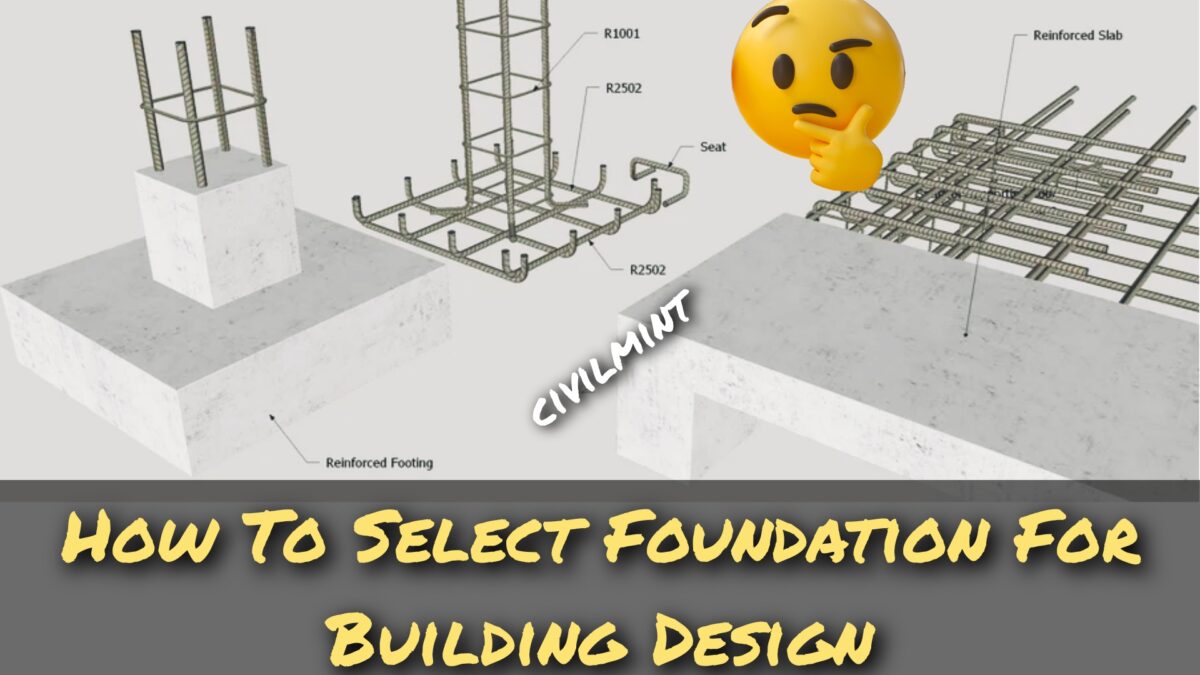In this blog article, we will learn How to Select the Foundation for Building Design.

Foundation is the key part of a structure. Superstructure transfer load to substructure via beam and columns.
Foundation transfers this load to the soil. So finally load is transferred to the soil.
The foundation design of a structure is a very critical thing in the field of structural design.
Foundation selection for building design basically depends on four important factors.
- Loads from superstructure
- Soil Bearing Capacity
- Type of Soil
- Water Table Level
The important factors affecting foundation design are as follows.
Table of Contents
1. Loads from Super Structure
Loading conditions originating from the superstructure are one of the factors that decide foundation selection. It is affected by the type of building, type of construction material, environmental factors, earthquake susceptibility, snow load, wind load, etc.
A material selection such as blockwork, steel, and concrete for construction affects the selection of foundation. The settlement estimation of the foundation is another important factor that relates to loads of the superstructure and affects the selection of the foundation.
2. Soil Bearing Capacity (SBC)
Soil Bearing Capacity or SBC is one of the most important factors in the selection of foundations. Based on soil bearing capacity selection of foundation can be made, whether it should be the shallow or deep foundation.
The maximum load per unit area is called Soil Bearing Capacity or SBC. This is the ultimate bearing capacity of soil given in the table. Dividing the ultimate soil bearing capacity safety factor we got the maximum safe bearing capacity of soil for the design of foundations.
3. Types of Soil
Different types of soil have different bearing capacities. From the top surface of the earth to 3-meter depth is termed as topsoil and then after 3 meters called subsoil. The bearing capacity of topsoil and subsoil is considered to select the type of foundation.
“Soil Bearing Capacity is the ability of soil by virtue it resists the structural loads without shear failure.”
If the soil has low bearing capacity then a stronger foundation is selected to bear the structural load.
3.1 Clay Soil
Clay soil has an incredible ability to retain water that is why it can expand and shrinkage can occur. Foundation structure can collapse due to settlement and uplift pressure which is why clay soil is not recommended. Raft foundation can be built on clay soil.
3.2 Peat Soil
It is impressively permeable, effectively compressible, and dim dark colored or dark shading soil which is ordinarily present close to wetlands. It experiences development and shrinkage because of dampness change, incredibly feeble in wording or burden conveying limit.
3.3 Silt
Silty soil, which is smooth to contact, is commonly not appropriate for foundation structure in view of its development which applies pressure against the foundation and harms it.
3.4 Sand and Gravel
Sand and gravel permit water seepage which is the reason that doesn’t cause structural development. Wet compaction of soil and sand makes great help for the establishment structure.
3.5 Rock
Rocks like limestone, bedrock, and sandstone have significantly high bearing capacities. This makes it suitable for supporting foundations of high-story buildings and skyscrapers.
4. Water Table Level
The water table is another critical standard that influences the foundation selection. the foundation should not be set on soil that experiences extension and compression because of water table vacillation. Thus, it should be constructed on fully dry soil or on fully wet soil.
Final Thought:
In this article, you have learned about how to select the foundation for building design. Loads from the superstructure, soil bearing capacity, type of soil, and water table level are the important things to consider while designing a foundation.
FAQS
Consult with a structural engineer or architect to determine the appropriate foundation based on soil conditions, building size and weight, and local building codes.
Soil conditions, building size and weight, local building codes, and climate and weather patterns.
A deep foundation, such as a pile foundation, may be necessary for a building of this height.
The strength of a foundation depends on soil conditions, building size and weight, and local building codes.
Pile foundations provide support for deep excavations and high loads, and they can be used in poor soil conditions.
Slab foundations are easy to construct, cost-effective, and suitable for buildings with low loads and good soil conditions.
Shallow foundations are used in good soil conditions and support loads close to the surface, while deep foundations transfer loads to deeper soil layers or bedrock.
The appropriate foundation depth depends on soil conditions, building size and weight, and local building codes.
A mat foundation is a thick slab that supports the entire building, while a raft foundation is a thin slab that supports isolated load-bearing points.
Yes. But, it should be done in the guidance of an experienced structural engineer.
